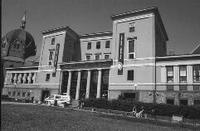Notes from my readings on libraries in Norway -- this one is from "A Voyage Through the Norwegian Library Landscape and Some Challenges on the Horizon" by Leikny Haga Indergaard (IFLA Journal vol. 31 no.2 (2005):
- P.134. Public Libraries - For more than two hundred years Norway has had a public library system open to all. The first reading societies (Leseselskap) were established in the 18th century and were founded on the belief in knowledge and reason fostered by the Age of Enlightenment. By 1840 there were 230 public libraries in Norway.
- P.135. Challenges for Academic and Research Libraries - Academic, special and research libraries are undergoing change and many smaller libraries are being closed. The transition from printed to digital material is speeding up with the latter showing a 30 percent increase last year.
- P.136. The Library as a Centre of Learning - The introduction of Quality Reform influences pedagogic development and promotes professional cooperation within institutions. Many educational organizations have established their own centres of learning, making the library a physical, integral part of study work.

From p.137 - Figure 4. The Oslo Public Library. Deichmanske
Bibliotek. Main building. Photo: Chris Erichsen.
- P.138. The Norwegian Library of Talking Books and Braille
- P.139. Seamless Library Services - A significant change in the library sector, spurred on by the establishment of the Archive, Library and Museum Authority, is the consolidation of the public and academic and special library sectors into one.
- P.139. On the Norwegian Digital Library

p. 142 - Figure 9. The bookmobile boat Epos, from the western part of Norway. Photo: Hordaland County Library.
- P.142. Picture of the bookmobile boat Epos
- P.142. Public Libraries and the Purchasing Programme for Contemporary Fiction and Non-fiction -- Through the Arts Council of Norway a purchasing programme was launched, guaranteeing publishers a sale of a certain minimum number of copies of each book published. The programme has worked well for more than 35 years based on the original principles, although it has undergone some changes regarding the number of copies and what categories of books are included... The reading public benefits from the programme by finding complete collections of modern fiction in their local public library, however small it may be. Bringing together a book and its reader in this way is really what the programme is all about.
- P.143. Lifelong Learning and Reading Programmes
Tag: IFLA

No comments:
Post a Comment
Join the conversation. Leave a comment :)
Note: only a member of this blog may post a comment.